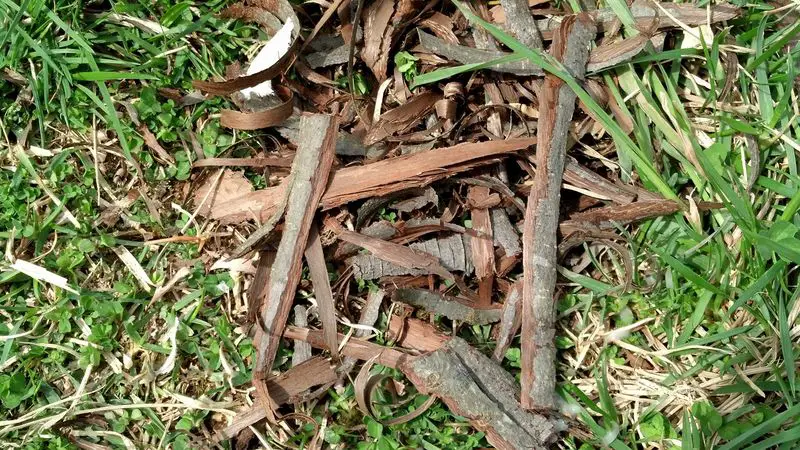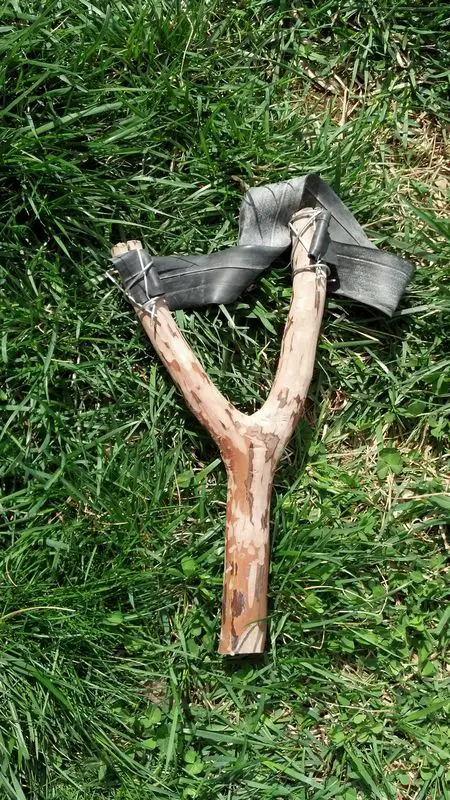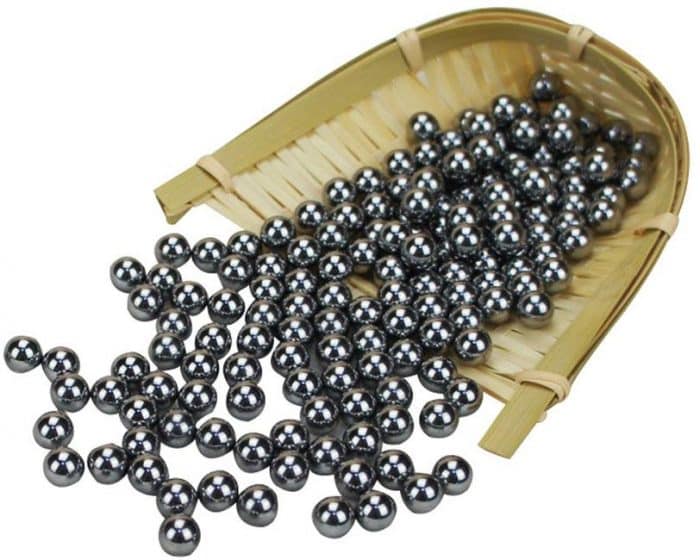Surviving in the wilderness requires strategy, creativity and art of using natural resources.
You definitely have to make do of what you can find around you.
On this trip, I found items that allowed me to make a DIY slingshot.

| Quick Navigation Bushcraft Slingshot Finding the Supplies Accessories & Mods Upgrading your DIY Slingshot Where Can You Use the DIY Slingshot? Conclusion |
Bushcraft Slingshot
Slingshots are small, light and versatile weapons. They are ideal for hunting small game and having some target practice fun.
One thing I noticed about slingshots is that the mechanics and size of them vary greatly due to the wide range of materials you can use to build them.
The beauty with slingshots is in their simplicity. Often, you will see them with three essential parts/components – an elastic band, a Y-shaped frame, and a tiny projectile, which will sail once you pull it back and release it.
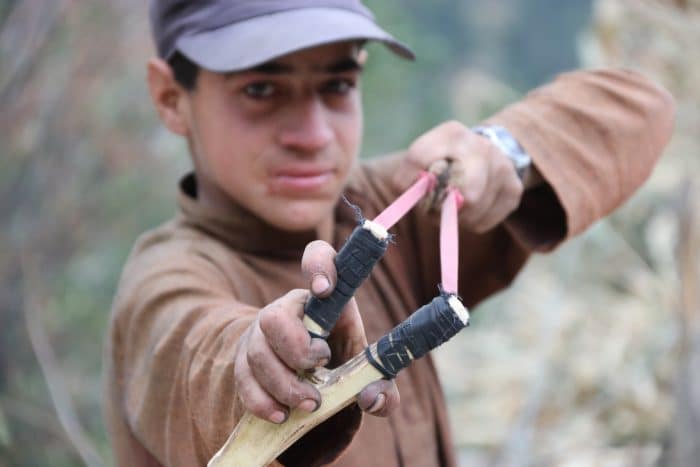
Before this weekend’s camping trip, I was in my local outdoors store looking for a decent slingshot, but none were available.
Here I am now, in the forest. I have my trusty Swiss Army knife, a Leatherman Wingman but NO SLINGSHOT. What would I ever do now?
I know… I’ll try to make a DIY slingshot, a real bushcraft slingshot.
Finding the Supplies
1) Y-shaped/forked branch:
First things first. I needed to find a forked branch.
I found a branch that seemed to be the right shape and used the saw on my Swiss Army Knife to saw it off.
This serves as the actual frame of your DIY slingshot. Make sure to look for a comfortably thick branch. It should be as wide as your thumb at the very least.
The branch should also be approximately 8 inches long starting from the top down to the bottom. The form should be found in the middle.
To increase your chance of making a truly legit DIY slingshot, look for a branch without knots or cracks as such might only cause the frame to become weak. The frame is the backbone of the slingshot.
If possible, choose hardwood, too. It is much better than softwood as it does not bend that easily. It would be best if you were able to get a maple wood branch.
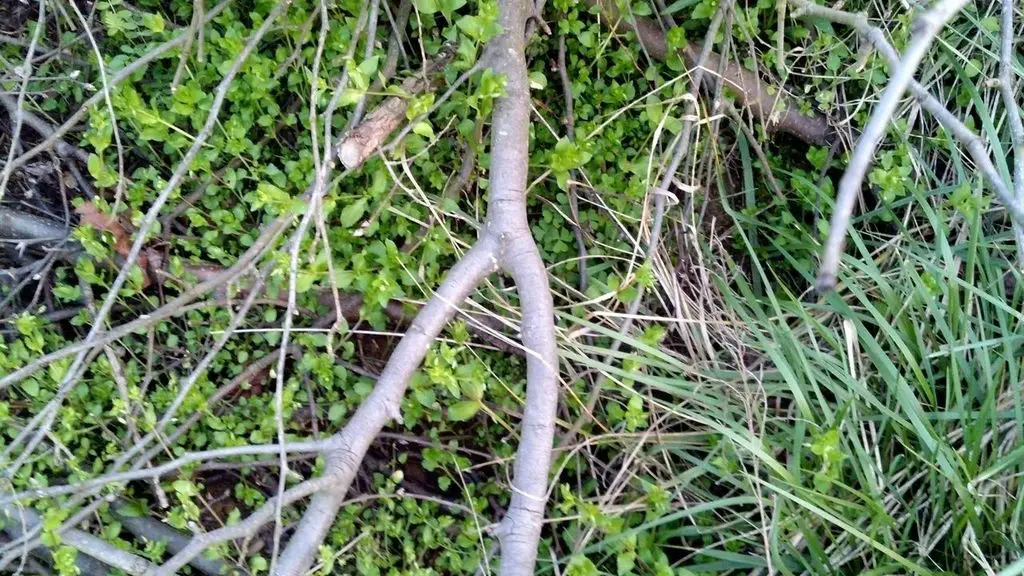
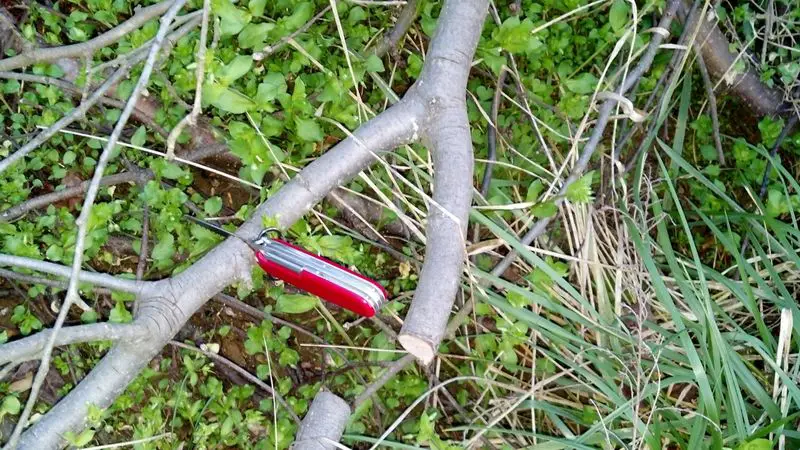
I now have my slingshot frame.
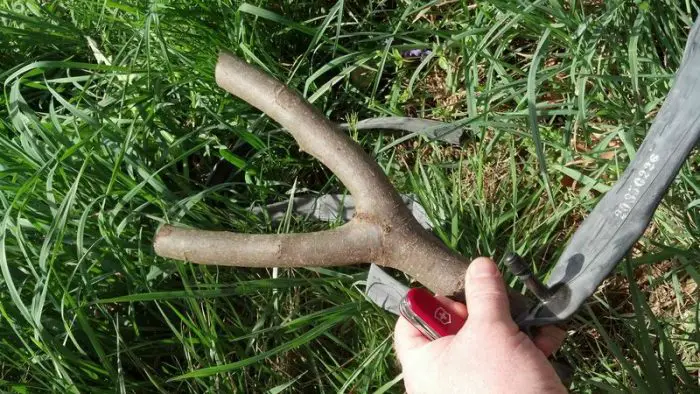
I’m sure I could have found a much better branch, but this would work just fine…
The next step was to strip the bark, then smooth or remove any bumps and rough spots.
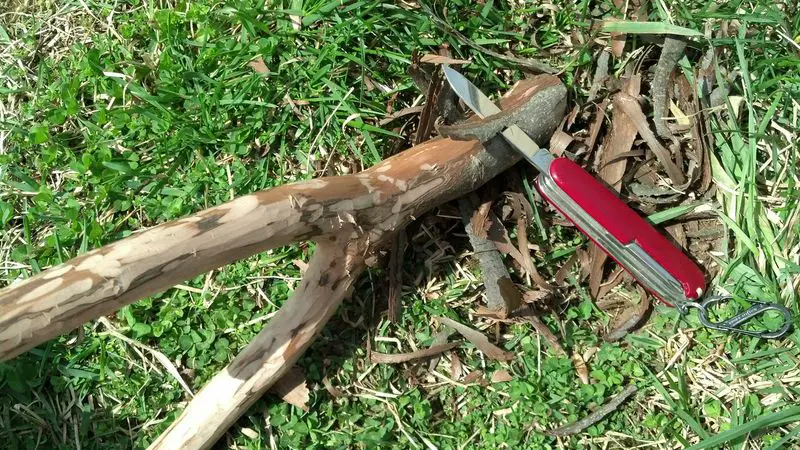
There we go. I have a smooth frame for my slingshot. As a provided a bonus, this left me with some free wood shavings, for the evening’s campfire.
2) Elastic band
Where in the world could I find something rubbery or springy for my bushcraft slingshot’s propulsion system?
I decided to hike back up to the road and walk along it to see if I could find some litter or discarded auto parts, that might fit the bill.
After hiking along the road for a little over an hour, I came across a bicycle inner tube. Not exactly what I was looking for, but it “should” work.
I put the inner tube in my outer pack pocket and headed back towards camp.
The elastic band is a critical part for your slingshot to shoot effectively. Look for a stretchy long one. You may use industrial-grade rubber bands but note that they might only be ideal for practice.
If you want to use your slingshot for serious hunting or during emergencies then it is highly recommended to use surgical tubing. You may also use a bicycle tire tubing as I’ve done.
Another idea I’ve had are to use exercise bands, which are on the increase from the recent weight loss movements.
Lastly, and some of you will not like this, but one or multiple condoms tied together will do the job, though may have less power than the above mentioned tubes.
Note that various bands have their unique traits so spend time experimenting. Find out which one truly works for the purpose you have in mind.
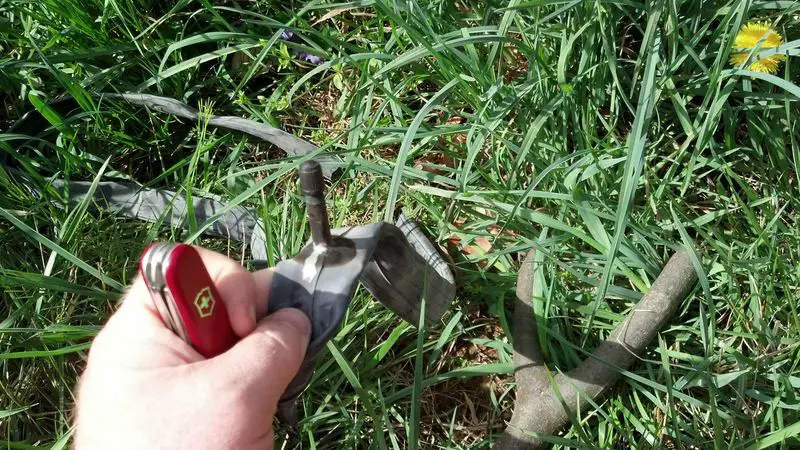
3) String, wire, dental floss, or staple fastener:
I kept my eyes open on the way back to camp for anything I could use to fasten the inner tube to the frame.
As I was walking past a fence row, I spied a spool of some type of metal wire.
It wasn’t mine, but I did stop and snip off about 12 inches of it with my Wingman multi-tool, and stashed that in my pack also.
Back at camp, I started looking at the slingshot frame, the inner tube and the wire, to if I could make this all come together.
I cut the inner tube to about 12 inches and wrapped each end around a twig.
Next, I pinched the wrapped end with some wire, preventing the tube from unwrapping from the twigs, on the ends.
A string of small diameter, staples, or wire, as we already saw should be sufficiently strong to secure the band to the slingshot frame in a similar manner I used with the wire. You may also find dental floss useful.
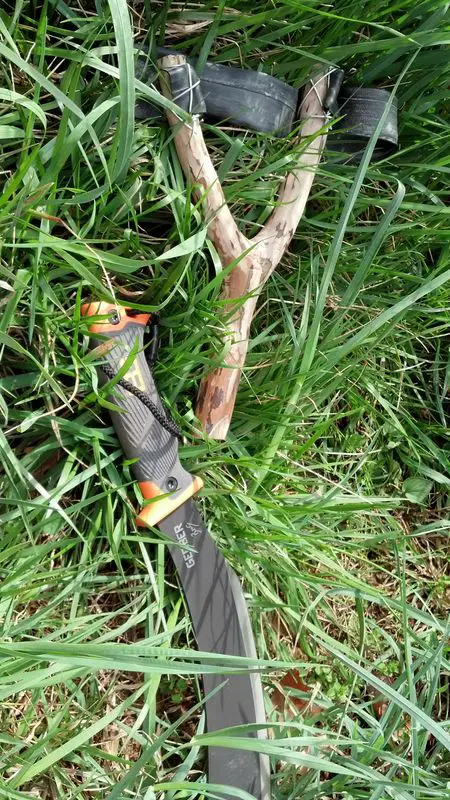
Then I held the slingshot frame and used the saw, from my Swiss Army Knife, to slot the arms of the slingshot, so I could slide the inner tube into them.
The twigs, wrapped at the end of the inner tube, prevented the inner tube from sliding back through the slots in the arms.
After wrapping the top of the arms of my slingshot with wire, to keep the inner tube from sliding up, out of the slots in the arms, I was holding what appeared to be a DIY slingshot.
I sure hope this thing will work!
This slingshot isn’t pretty, nor is it perfect, but it does function quite well. After firing a few rocks from it, I quickly realized that I needed to trim the width of the inner tube to make it easier to drawback, but that was simple.
Below is a short video to show my bushcraft slingshot in action. My 7-year-old daughter loves to help with the blog, so she asked me if she could shoot a video. How could I say “no”?
Keep in mind that I had been camping all weekend.
After I got home, I had to do some planting in the garden. I apologize for looking dishevelled and gross. I wasn’t planning on making a video, else I’d have dressed up pretty, for you guys.
This is just one of many methods I could have used to fashion a bushcraft DIY slingshot, or any other improvised tool, weapon or implement.
I hope this gets you thinking about being flexible and using what you find and utilize in your surroundings.
Most of this was typed on a Chromebook, from within my tent.
Add On Accessories & Mods to Buy
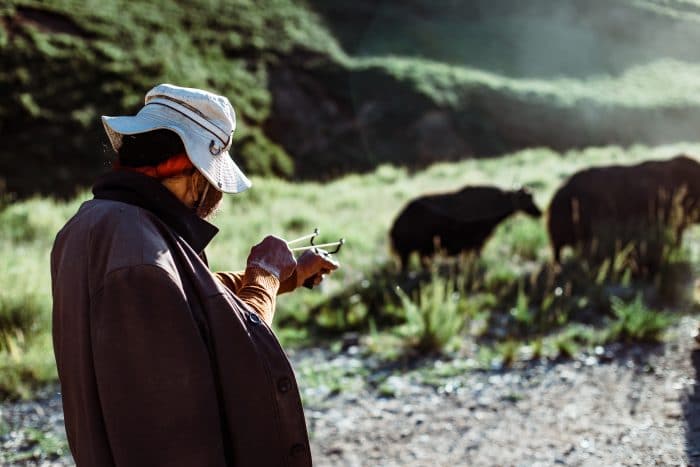
4) Slingshot pouch – One of the ideal materials for the pouch would be leather. You can also use a heavy cloth or a nylon rip-stop type of material.
5) Ammunition – Among the types of ammunition that you can use are steel balls, glass marbles, and ground stones. Look for smooth yet large stones as they tend to travel farther due to their mass.
Once you have gathered all supplies, you can easily make your own slingshot based on the way I have created mine.
Upgrading your DIY Slingshot
Have you finally made your own slingshot? Then note that there are several upgrades that you can make to improve its functionality. While it is unnecessary to make upgrades on your slingshot, having them will make yours perform a wider range of purposes.

Cut frames from boards – In this upgrade, you should consider cutting frames from boards instead of making use of a branch from a tree.
If you decide to do this then remember that the boards’ wood grain might be weaker compared to a tree branch. With that in mind, create a thicker frame. Make sure that the grain’s direction is from the top to the bottom, too.
Use a metal frame – You may also want to use a thick metal frame, which is known for its lightness and strength.
The majority of commercial slingshots you can find today feature a metal frame because of the two mentioned positive traits. It is also possible to bend your own metal frame. The only thing you have to guarantee is that there is an adequate cushion in the handle.
Where Can You Use the DIY Slingshot?
There are actually a few reasons why having your own DIY slingshot is a must. In fact, the DIY slingshot I created served a lot of purposes. One thing that it can do is to make a fantastic emergency weapon. The fact that it is light and small makes it easy to use, especially during emergencies.
I’m sure you will also find the process of practicing with it fun and exciting because it is not necessary to do it at a large range. I also noticed how good the DIY slingshot is when it comes to hunting. You can expect small game, like rabbits and squirrels, to fall with each blow.
Another advantage of a slingshot when used for hunting is that it tends to work quietly. It does not draw attention, making it a lot easier to hunt. Since it is small, maneuvering it while in the woods is also easy.
Conclusion
A slingshot is indeed one of the best weapons for hobbyists, preppers, survivalists, and anyone concerned about disasters and emergencies. Practice creating your own slingshots and upgrade them. I’m sure you will love using them not only in the woods but for any other purpose you have in mind.


